When work moves between teams, from development to marketing to sales, progress often stalls. Handoffs are messy, priorities get lost in translation, and no one has a clear view of the entire workflow. The real challenge is not just managing individual work items, but visualizing the entire delivery process from start to finish.
Using a kanban board template provides a proven framework for bringing clarity to any process. It gives you a ready-made structure for organizing projects and tracking progress without starting from scratch. This guide explores 15 different templates designed for specific workflows, from software development and IT support to marketing campaigns and HR onboarding.
Each template offers a starting point for solving specific workflow challenges. You will find options that help you see exactly what needs doing, what is in progress, and what is complete. The key is finding a flexible system that allows you to adapt these frameworks to your team’s unique needs, ensuring seamless collaboration across engineering, business, and leadership.
Try monday devKey takeaways
- Start simple with basic templates — Begin with three columns (To Do, Doing, Done) and add complexity gradually as your team masters the fundamentals.
- Choose templates that match your workflow — Software teams need development-specific columns while marketing teams require campaign tracking features for maximum effectiveness.
- monday dev transforms basic templates into powerful systems — Get unlimited customization, AI-powered automation, and enterprise security that scales with your team’s growth.
- Focus on visual clarity and flexibility — Effective templates use clear column headers, logical card organization, and customizable fields that adapt to your changing needs.
- Track the right metrics for continuous improvement — Monitor cycle time, throughput, and work-in-progress limits to identify bottlenecks and optimize your team’s workflow efficiency.
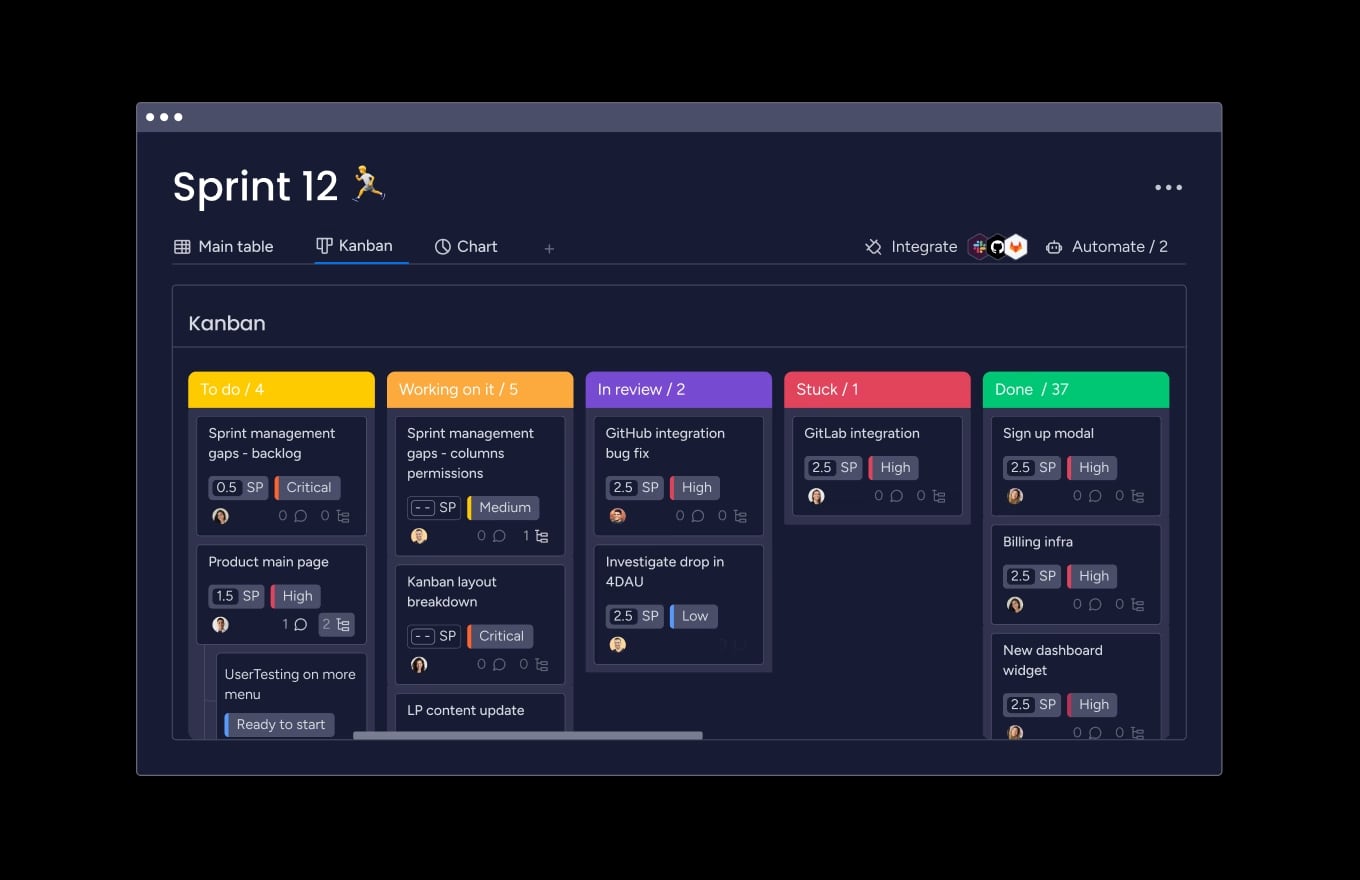

"monday dev empowered us to optimize our GTM approach, resulting in faster, more dependable deliveries"
Steven Hamrell | Director of Product Management
"monday dev empowers us to manage the entire development process on one platform so we can speed up product delivery and improve customer satisfaction"
Mitchel Hudson | Head of Technology
"We're operating in an open, deep trusting, transparent environment with no silos of information. It's about completely opening access to everyone who needs it."
Alan Schmoll | Executive Vice President, Vistra Platform15 free kanban board templates to transform your workflow
As projects move across departments, the real challenge often isn’t the work itself — it’s keeping priorities clear and handoffs smooth. Miscommunication between teams can slow progress, create bottlenecks, and make it tough to see where things stand at any given moment.
Kanban board templates offer a practical way to cut through that complexity. By giving you a ready-made structure tailored to different types of workflows, they make it easier to spot roadblocks, keep tasks moving, and ensure everyone stays aligned.
Below, you’ll find 15 free kanban board templates built for common scenarios: from managing software sprints to running marketing campaigns to streamlining HR onboarding. Each one is designed to help you visualize the flow of work, adapt the framework to your team’s needs, and keep collaboration seamless across functions.
1. Basic kanban template for getting started
This template introduces kanban methodology with the simplest possible setup — perfect for teams who want to visualize work without complexity.
- Structure: Three columns (To Do, Doing, Done) with cards moving left to right as work progresses.
- Features: Minimalist design, drag-and-drop functionality, and basic color coding for priorities.
- Best for: Small projects, teams new to visual project management, or introducing kanban to beginners.
2. Software development kanban template
Development teams need templates that match their technical workflows. This template streamlines everything from initial coding through deployment.
The columns follow the development lifecycle: backlog, development, code review, testing, and deployment. You can integrate with GitHub or GitLab for automatic updates. Sprint planning features help also manage iterative development cycles.
Choose this template when managing feature development, bug fixes, or release cycles. It’s especially valuable when you need visibility across complex development processes with multiple stakeholders.
3. IT support ticket kanban template
Support teams manage a constant flow of customer requests, and this template helps organize tickets efficiently while keeping accountability clear. The workflow includes columns for: new Tickets, in progress, waiting for customer, and resolved. Built-in priority handling makes it easy to escalate urgent issues, while SLA tracking helps teams meet response-time commitments. This template is best suited for managing high volumes of support requests, making it easier to track resolution times, maintain service levels, and keep customers informed throughout the process.
4. Marketing campaign kanban template
Marketing teams often juggle multiple campaigns across different channels, and this template provides structure for the entire campaign lifecycle.
The workflow typically moves from ideas through planning, content creation, review, published, and analysis. It can also integrate with content calendars and track performance metrics directly on the board.
This template works well for coordinating multi-channel campaigns, helping teams stay aligned on content creation, approval processes, and performance analysis.
5. Product launch kanban template
Product launches demand careful coordination across multiple departments, and this template brings all phases into a single, visual workspace. The structure includes pre-launch, launch, and post-launch columns, each of which can be customized with sub-stages to fit the specific steps your team follows. This makes it easy to plan every detail, from early market research and messaging development to launch-day execution and post-launch analysis.
Built-in milestone tracking helps teams hit critical deadlines, while collaboration features ensure that marketing, product, sales, and support stay aligned throughout the process. By mapping the entire launch in one place, this template reduces the risk of missed tasks and keeps the entire team focused on delivering a successful product release.
6. Bug tracking kanban template
Quality assurance (QA) and development teams need a systematic way to manage bug resolution, and this template provides clear visibility from discovery through to resolution. The workflow typically moves through reported, investigating, fixing, testing, and closed stages, making it easy to see where each issue stands at any given time. Severity-based swimlanes help prioritize the most critical bugs, while duplicate detection prevents wasted effort on issues that have already been logged.
This template is really useful for large codebases or projects where QA and development teams need to stay tightly coordinated. By ensuring bugs are addressed according to their impact, it helps maintain software quality and supports smoother releases.
7. Personal productivity kanban template
Individual productivity benefits from visual organization too. This template helps manage personal workflows and daily priorities.
Simple columns include: ideas, this week, today, and done. Personal goal tracking features help to further maintain focus on long-term objectives, while time-blocking capabilities support daily planning.
Choose this template for personal task management. It adapts easily to changing schedules while keeping priorities visible.
8. Customer support kanban template
Customer service teams need streamlined workflows to handle requests quickly and maintain high satisfaction levels. This template lays out the full support journey in a clear, visual flow.
- Requests move through columns such as: new, in progress, waiting on customer, and resolved to keep ticket status transparent.
- SLA monitoring helps teams stay on top of response-time commitments.
- Customer feedback can be captured directly in the workflow, creating a feedback loop that improves service quality over time.
This template is extremely helpful when support comes through multiple channels — email, chat, or phone — and consistency across all of them is critical. It gives managers visibility into workloads while ensuring customers get timely, reliable support.
9. Content creation kanban template
Editorial teams often juggle multiple pieces of content at once, and this template helps manage the entire production process from start to finish. The workflow typically moves through ideas, research, writing, editing, and published columns, giving everyone visibility into where each piece stands. Integration with editorial calendars keeps deadlines front and center, while performance tracking tools provide insight into how published content performs.
This template works well for coordinating between writers, editors, and marketing teams. By mapping out each stage of content creation, it ensures a smooth flow from initial concept to final publication — without missed steps or unclear ownership
10. Sprint planning kanban template
Agile teams working in sprints often rely on a scrum board to manage iterative development, and this template provides a clear view of each sprint cycle from planning to completion. The workflow is organized into columns such as sprint backlog, in progress, review, and done, making it easy to track tasks as they move through the iteration.
Velocity tracking gives teams insight into how much work they can realistically take on in future sprints, while burndown chart compatibility makes progress against sprint goals easy to monitor. This scrum board kanban template is ideal for teams working in time-boxed iterations, helping them stay focused on sprint priorities while maintaining visibility into overall progress.
11. Portfolio management kanban template
Executives and PMOs often need to oversee multiple projects at once, and this template provides a high-level view of how every initiative is progressing. It’s designed to bring clarity to complex portfolios where priorities, risks, and resources need to be carefully managed.
- Workflow: Columns such as initiatives, in progress, at risk, and completed give quick insight into project status.
- Risk management: Visual indicators call out projects that may be falling behind or running into issues.
- Resource allocation: Tools for balancing workloads across teams ensure no group is overextended.
This portfolio management kanban template is particularly valuable when coordinating several projects under one strategic umbrella. It helps leadership teams maintain alignment with business goals while keeping delivery on track across multiple initiatives.
12. Remote team collaboration kanban template
Distributed teams often face communication hurdles, and this template is designed to create transparency across time zones and locations. It builds on the standard kanban structure but adds collaboration-focused features that make remote work easier to manage. Time zone indicators highlight team availability, while asynchronous update options ensure progress is visible even when people are working different hours.
This remote team collaboration kanban template is best suited for teams spread across regions or working flexible schedules. By keeping updates centralized and accessible, it helps maintain alignment and momentum despite physical separation.
13. Sales pipeline kanban template
Managing a sales pipeline requires more than just tracking leads: it’s about making sure every opportunity moves forward without slipping through the cracks. This template gives sales teams a clear, structured view of the entire journey, helping reps stay organized and managers forecast revenue with confidence.
- Workflow: Columns reflect common stages such as lead, contacted, qualified, proposal sent, negotiation, and closed won/lost.
- Deal tracking: Built-in value fields support revenue forecasting and provide visibility into pipeline health.
- Follow-up support: Automated reminders reduce the risk of stalled deals by keeping reps on top of next steps.
With this sales pipeline kanban template, teams gain visibility into both individual opportunities and overall performance, ensuring a more predictable and efficient sales process.
14. HR onboarding kanban template
Bringing on new employees involves multiple steps, documents, and stakeholders, and this template ensures no part of the process gets overlooked. The workflow typically moves through documents, orientation, training, probation, and fully onboarded stages. Integrated checklists track required activities, while compliance features help maintain accurate records for HR teams.
This HR onboarding kanban template is hugely valuable when hiring at scale, as it standardizes the process while still tracking each employee’s progress individually. By making every step visible, it helps new hires feel supported and teams stay confident that nothing has slipped through the cracks.
15. Event planning kanban template
Event coordination requires careful planning, multiple deadlines, and collaboration with external partners. This template brings everything into one place so teams can manage both the big picture and the fine details. Columns organize work into pre-event, event day, and post-event phases, while timeline integration makes milestone tracking easy. Vendor management features also keep external partners aligned with internal schedules.
Ideal for conferences, product launches, or company events, this event planning kanban template ensures every moving part is accounted for. From early logistics to post-event follow-up, it provides the structure needed to deliver smooth, well-executed events.
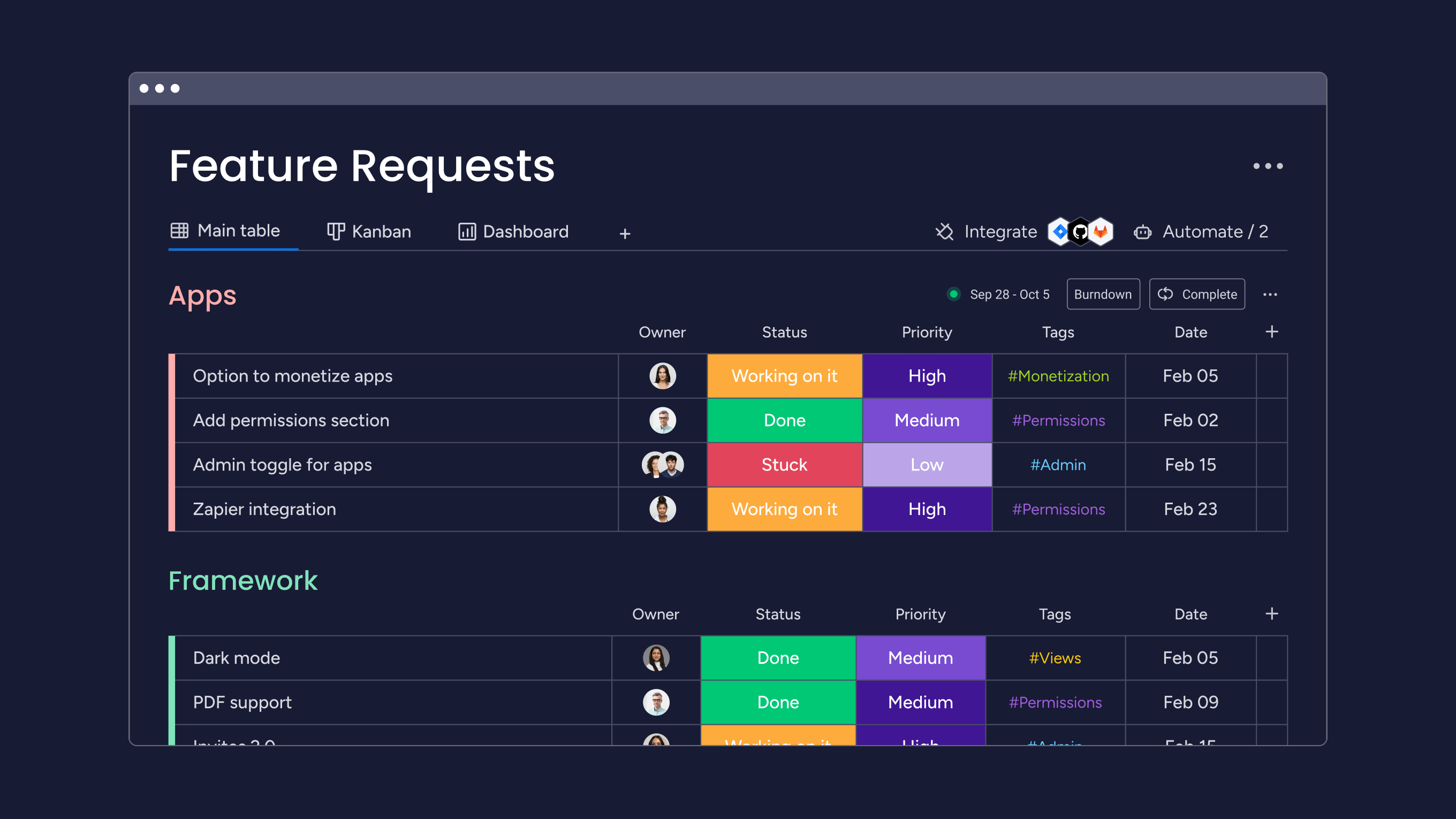
What makes an effective kanban board template
An effective kanban board template does more than organize tasks — it can transform how teams collaborate and deliver results. In fact, research shows that 87% of adopters find Kanban a more or much more effective approach compared to their previous methods. The most effective templates share a few common traits:
- Visual clarity: Workflow status should be instantly recognizable. Clear column headers, logical card organization, and intuitive color coding make information easy to scan at a glance.
- Flexibility: Strong templates evolve with your team. Customizable columns, fields, and labels ensure the framework adapts as processes change. monday dev excels here, offering unlimited customization that fits your exact workflow.
- Built-in analytics: Metrics such as cycle time, throughput, and work-in-progress (WIP) limits provide visibility into how work flows. With this data, teams can spot bottlenecks early and adjust before delivery suffers.
Understanding key Kanban terminology also helps teams get the most from any template. Two concepts in particular make a big difference: work-in-progress (WIP) limits, which cap the number of tasks allowed per column to prevent overload, and swimlanes, horizontal rows that separate work types, projects, or responsibilities for added clarity.
When these elements come together, a kanban board template becomes a system that supports continuous flow, reduces friction, and keeps teams aligned around shared goals.
Essential components every kanban card template needs
Well-designed kanban components work together to create transparency and momentum. They can also be paired with a kano model template to connect day-to-day execution with customer satisfaction insights, giving product teams a clearer picture of both progress and impact.
At the heart of the system are kanban cards, each representing a single work item. Cards should include essentials like a clear title, assigned team members, due dates, and priority indicators so responsibilities and timelines are always visible.
Workflow columns define the stages of your process. Most teams find 3–7 columns provide the right level of visibility — starting with to do, in progress, and done, then adding specialized columns as the process matures.
Work-in-progress (WIP) limits keep teams from overloading any stage. Setting a maximum number of tasks per column helps maintain steady flow. In monday dev, these limits are supported with visual indicators that alert teams before bottlenecks form, making it easier to sustain consistent delivery.
Finally, swimlanes add another layer of organization, dividing work by priority, project type, or ownership. For complex workflows, this separation makes progress easier to track and ensures nothing gets lost across parallel efforts.
Try monday dev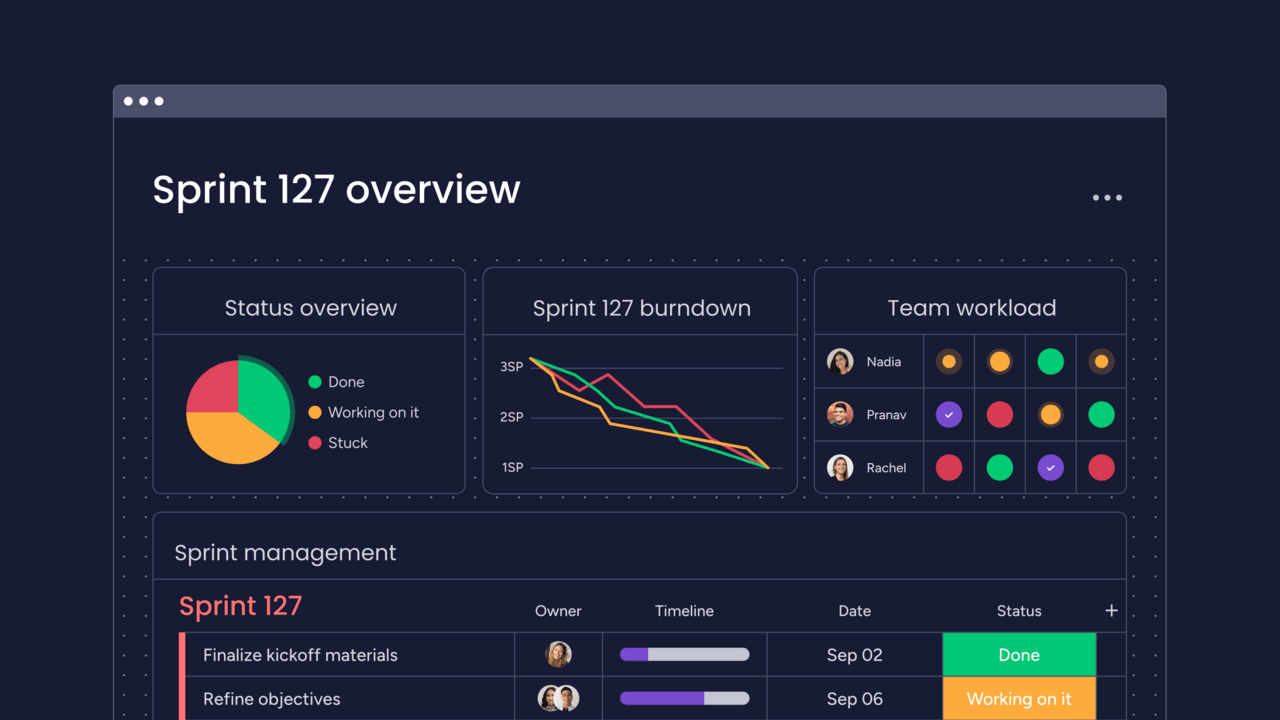
Choosing the right free kanban template for your team
The template you choose can shape not only how quickly your team gets up to speed but also how sustainable the system is over time. The right fit depends on the way your team works, the complexity of your processes, and how well the template connects with the tools you already use.
- Team size and structure: Smaller teams often do best with simple, lightweight templates that emphasize clarity. Larger or cross-functional groups may need added depth — features like multiple swimlanes, reporting dashboards, and layered permissions help manage complexity.
- Workflow complexity: A basic template works well for straightforward processes. But if your projects involve approvals, dependencies, or compliance requirements, it’s better to start with a template designed for advanced customization.
- Integration needs: For teams already working across several platforms, integrations make a huge difference. With monday dev, built-in integrations turn the kanban board into a central hub where projects, communication, and reporting all connect.
Choosing with these considerations in mind ensures the template fits both your current workflow and your long-term goals.
How to customize your kanban board template
Customization turns a standard kanban template into a workflow system that reflects the way your team actually works. The key is to focus on adjustments that improve productivity while keeping the process simple.
- Custom fields allow you to capture team-specific details such as priority levels, client names, project types, or completion percentages. These fields add context so team members can quickly understand what matters most and act accordingly.
- Automation helps reduce repetitive tasks. You can create rules that move cards automatically, send reminders when deadlines are missed, or assign tasks based on predefined criteria. With monday dev, there are more than 150 ready-to-use automation recipes, along with options to build custom automations.
- Team-specific views make sure everyone sees the information most relevant to their role. For example, developers might focus on technical details, while managers need high-level progress summaries. Flexible views let both groups work from the same board without unnecessary clutter.
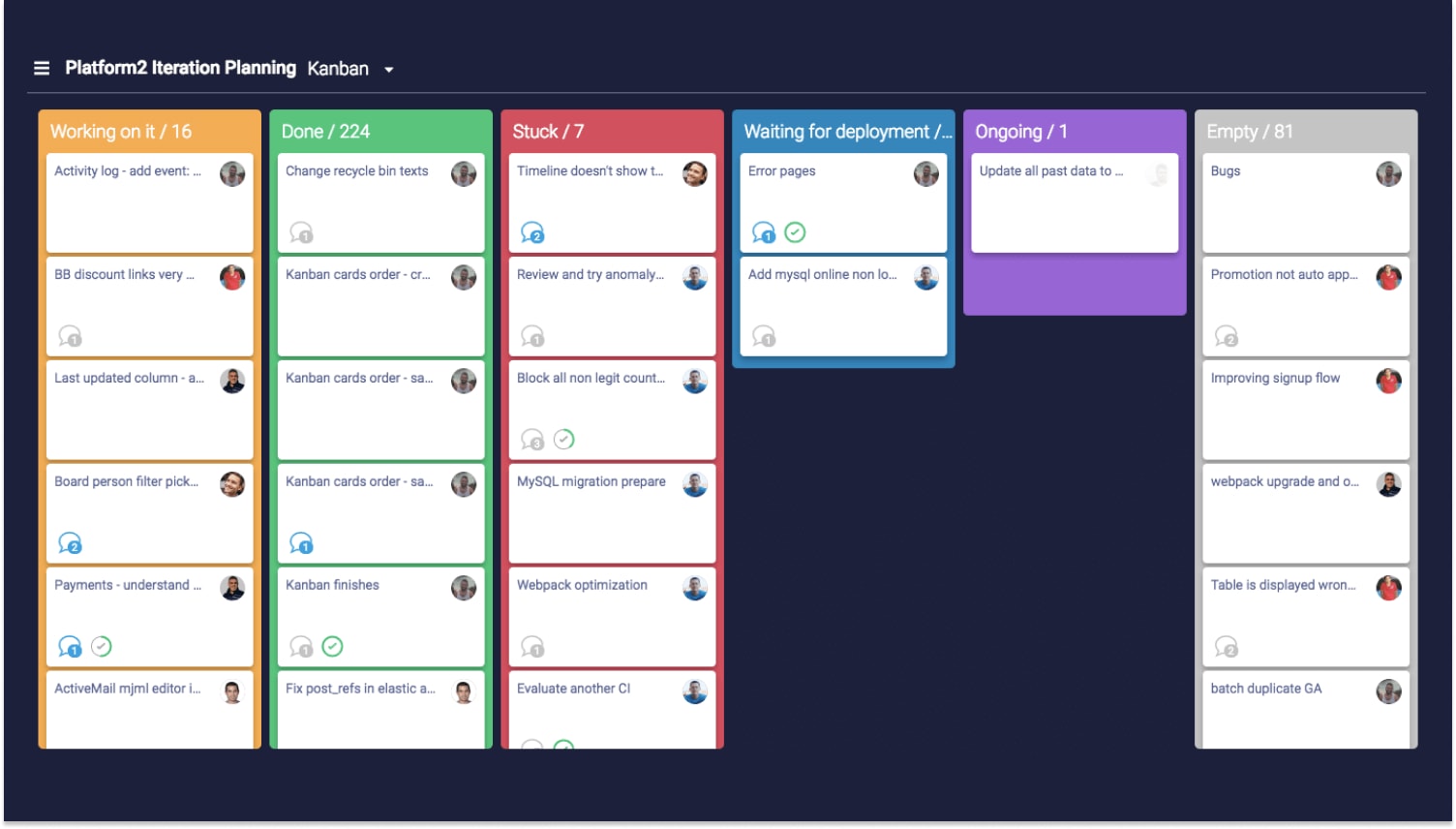
Kanban templates for different industries
Kanban adapts to virtually any industry by addressing unique workflow requirements through an efficient kanban flow. Looking at how different sectors apply kanban templates can also really help you identify the features most relevant to your team:
- Software development: Templates often blend Agile practices with visual management. They support code reviews, deployment pipelines, and bug tracking, with integrations into tools like GitHub and continuous integration systems for seamless delivery.
- Marketing: Campaign management, content creation, and approvals all benefit from structured workflows. Templates typically include ideation columns, review cycles, and performance tracking, while visual elements such as image previews make creative processes easier to manage.
- IT services: Incident management and service delivery rely on fast response and prioritization. Templates may include priority swimlanes, SLA tracking, and escalation procedures, with integrations to monitoring systems that improve response times.
- Cross-functional teams: When departments need to coordinate, templates with multiple swimlanes, dependency tracking, and built-in communication features help maintain alignment across different processes.
By tailoring templates to industry-specific requirements, teams can create workflows that not only fit their processes but also scale as demands grow.
Best practices for kanban board implementation
Implementing a kanban board isn’t just about setting up columns and cards. Success often comes from planning carefully at the start and then refining as the team gains experience. A few practices in particular tend to make adoption easier and the benefits longer lasting.
One helpful approach is to apply lean project management principles. Many teams begin with just three columns — to do, in progress, and done — and gradually introduce more complexity as the system becomes second nature. This way, the board grows with the team rather than overwhelming it from the beginning.
Another consideration is setting work-in-progress limits that match team capacity. A practical rule of thumb is one to three items per person. Tools like monday dev make this simple by flagging when limits are close to being exceeded, helping teams keep flow steady without micromanaging.
It also pays to schedule regular reviews, not as performance evaluations but as conversations about the process itself. These sessions highlight what’s working well, surface bottlenecks, and create space for small improvements. Over time, this rhythm builds a culture of continuous improvement where the kanban board becomes a living system that adapts with the team.
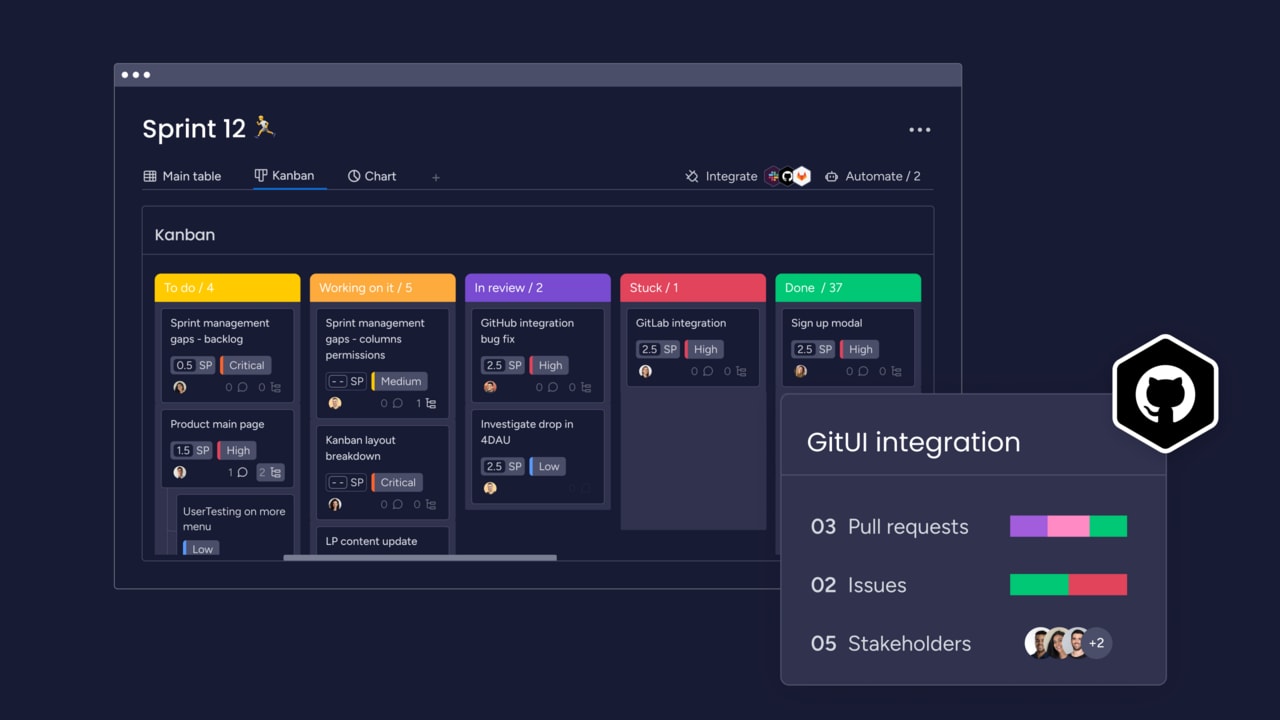
Sample kanban board layouts and examples
Seeing how different layouts work in practice can help teams choose the right structure for their needs. The best boards strike a balance between simplicity and functionality, giving just enough detail without creating clutter.
Single-team boards are well suited for smaller groups with straightforward workflows. Most use three to five columns to represent key stages, while color coding helps distinguish work types or priorities in a clean, easy-to-read way.
Multi-team portfolio views make it easier to coordinate across related projects. Swimlanes separate the work of individual teams but still keep dependencies visible. This allows managers to track overall progress and allocate resources more effectively.
Hybrid approaches such as Scrumban blend kanban visualization with sprint practices. Boards often include sprint boundaries, story points, and burndown charts while still preserving the continuous flow that makes kanban flexible.
Kanban board vs other project management methods
| Method | Workflow style | Best for | Key strengths |
|---|---|---|---|
| Kanban | Continuous flow | Ongoing work, support teams | Flexibility, visual clarity |
| Scrum | Time-boxed sprints | Product development | Predictability, team focus |
| Waterfall | Sequential phases | Fixed requirements | Clear milestones, planning |
| Gantt charts | Timeline-based | Complex dependencies | Resource scheduling |
When looking at kanban vs scrum, the difference often comes down to flexibility versus structure. Kanban suits support teams or environments where priorities shift frequently, since work flows continuously through the system. Scrum, by contrast, is designed for predictable delivery cycles with stable requirements, giving teams focus through time-boxed sprints.
Kanban and waterfall reflect two very different mindsets. Kanban adapts easily to evolving scope and changing priorities, while waterfall emphasizes sequential phases and detailed upfront planning. Waterfall works well when requirements are fixed and predictability is more valuable than flexibility.
Kanban and Gantt charts also highlight different ways of visualizing work. Kanban focuses on workflow and task progression, while Gantt charts lay out timelines and dependencies. Many organizations use both together — kanban to manage daily execution and Gantt to oversee long-term scheduling and resource planning.
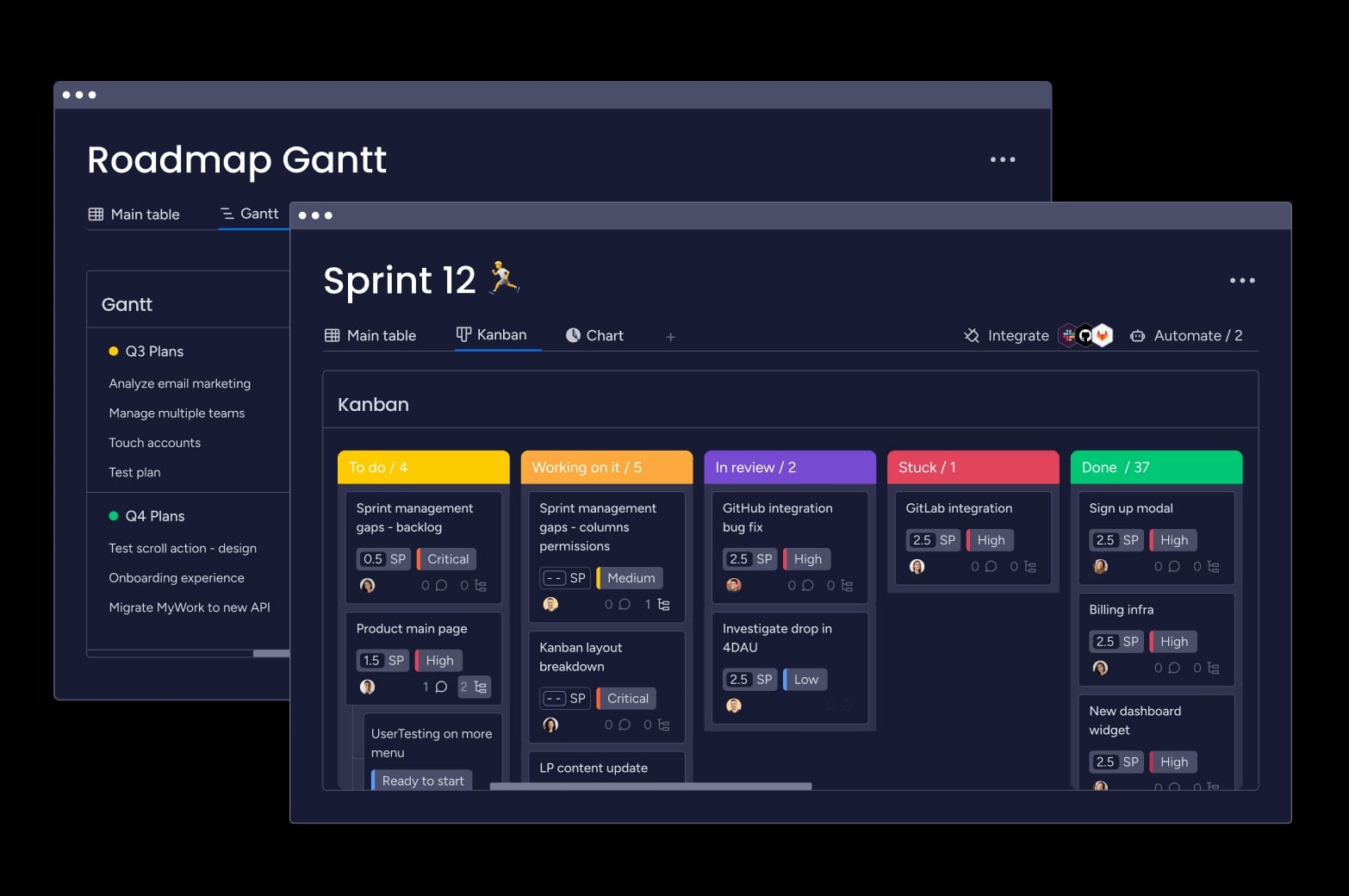
monday dev Testimonials

"monday dev empowered us to optimize our GTM approach, resulting in faster, more dependable deliveries"
Steven Hamrell | Director of Product Management
"monday dev empowers us to manage the entire development process on one platform so we can speed up product delivery and improve customer satisfaction"
Mitchel Hudson | Head of Technology
"We're operating in an open, deep trusting, transparent environment with no silos of information. It's about completely opening access to everyone who needs it."
Alan Schmoll | Executive Vice President, Vistra PlatformTransform your workflow with kanban capabilities from monday dev
The right platform can take kanban beyond simple task tracking and turn it into a system that scales with your engineering organization. With developer-focused features and built-in flexibility, monday dev delivers exactly that as a Kanban tool.
AI-powered workflows automate routine tasks so teams can focus on valuable work. The Code Review AI Block analyzes pull requests automatically, while the Bug Prioritization engine uses machine learning to rank issues by severity. Git integration keeps repository activity in sync with kanban cards, eliminating manual updates and reducing context switching.
Customization ensures every board fits real engineering workflows. Fields for story points or technical debt tracking, CI/CD automation rules triggered by commits, and sprint retrospective views help teams fine-tune their process. The GraphQL API makes it simple to connect with existing tools, so the system grows alongside your stack.
For larger organizations, enterprise-grade security supports safe adoption at scale. SOC 2 Type II compliance, role-based access controls, SAML/SSO, and detailed audit logs protect sensitive information while maintaining the collaborative benefits of kanban across technical and business teams alike.
For software development teams seeking an agile solution designed to bridge the gap between engineering and business, monday dev offers kanban capabilities that turn standard templates into a powerful framework for managing complex workflows.
Try monday devFrequently asked questions
What is the difference between a kanban board and a kanban template?
A kanban board is the actual workspace where teams manage their work, while a kanban template is a pre-designed framework that provides the structure for creating new boards. Templates serve as blueprints with predefined columns, card layouts, and workflow configurations that teams customize for their needs.
How many columns should a kanban board have?
Most kanban boards work effectively with 3-7 columns, as this range provides sufficient workflow visibility without creating confusion. The optimal number depends on your workflow complexity — simple processes need 3-4 columns while complex workflows benefit from 5-7 columns.
Can I use multiple kanban templates for one project?
Yes, complex projects often benefit from multiple connected kanban boards, each serving different aspects of the work. For example, software projects might use separate boards for feature development, bug tracking, and deployment management with integration maintaining visibility.
Are free kanban templates suitable for enterprise teams?
Free kanban templates work for basic workflow management, but enterprise teams typically require advanced features like automation, analytics, and integration capabilities. Enterprise teams also need security features, compliance capabilities, and scalability that free options rarely provide.
How do I migrate from Excel to a digital kanban board?
Migrating from Excel to a digital kanban board involves transferring task lists into kanban cards and organizing them into workflow columns. Digital boards offer real-time collaboration, automated notifications, and integration advantages that Excel cannot match.
What metrics should I track on my kanban board?
Track cycle time (task completion duration), throughput (completed tasks per period), and work-in-progress levels to identify bottlenecks and optimize efficiency. Additional metrics like lead time and blocked task frequency provide deeper workflow insights.
 Get started
Get started 


